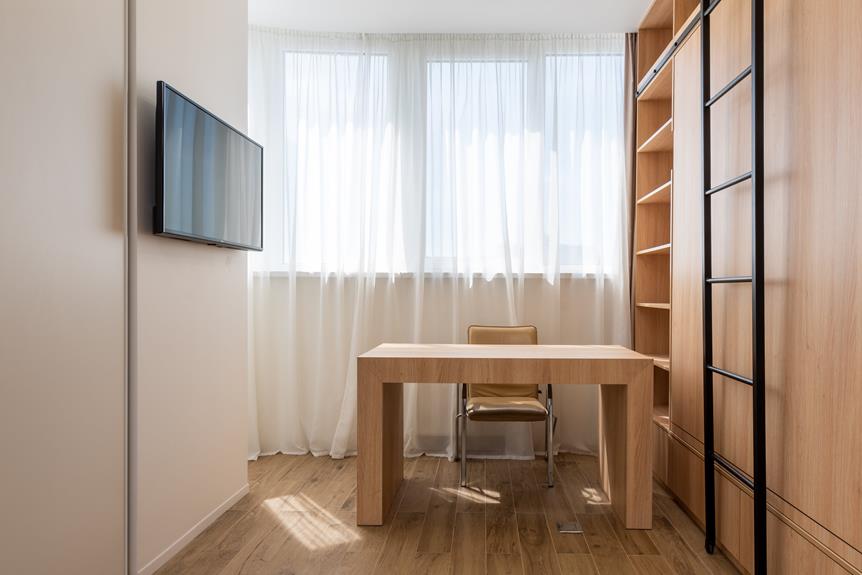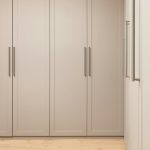Is your home office space feeling cramped and disorganized? You may have heard the theory that optimizing your closet for storage can be a game-changer.
But is it really possible to turn your closet into a functional and efficient home office storage solution? With a few simple strategies, you can transform your closet into a space that not only stores your belongings but also provides a well-organized and productive workspace.
Imagine the potential of creating a seamless and clutter-free environment where everything has its place, allowing you to focus on your work without distractions.
Key Takeaways
- Assess and utilize closet space efficiently by taking inventory of items, identifying unused areas, and categorizing belongings to determine the space needed.
- Implement vertical storage solutions such as shelves, hanging organizers, and floor-to-ceiling shelving units to maximize space and keep frequently used items easily accessible.
- Declutter and organize the closet by sorting items into categories, using clear containers or bins, and creating designated sections for different item types.
- Set up a productive workspace by positioning the desk and chair ergonomically, optimizing lighting and organization with tools like desk organizers and file cabinets, and adding personal touches that inspire and enhance productivity.
Assessing Your Closet Space
Assess your closet space by taking inventory of the items you need to store and identifying any unused or underutilized areas. To maximize efficiency, start by categorizing your belongings and determining how much space each category requires. This will help you visualize the ideal closet layout for your home office storage needs.
Begin by organizing your items into groups such as office supplies, paperwork, technology, and miscellaneous items. Measure the space needed for each category and consider the frequency of use for easy accessibility. This will allow you to allocate specific areas of your closet for different types of items, ensuring that commonly used items are within reach while those used less frequently can be stored in less accessible areas.
Once you have a clear idea of the space required for each category, assess your closet layout. Identify any shelves, rods, or drawers that can be adjusted or added to accommodate your storage needs. Consider utilizing vertical space by adding shelves or installing hooks to hang items such as bags or cords. Evaluate the underutilized areas such as the back of the closet door or the floor space, as these areas can often be optimized for additional storage.
Decluttering and Organizing
Now it's time to tackle the clutter and get your home office closet organized.
Start by sorting items into categories, such as office supplies, electronics, and paperwork.
Make use of vertical space by installing shelves or hanging organizers to maximize storage.
Consider investing in storage bins, baskets, or drawer dividers to keep everything neatly organized and easily accessible.
Sort by Category
Start by grouping similar items together to make the decluttering process more efficient. Categorizing items allows you to easily locate what you need and optimize your closet space. Consider these tips to effectively sort your home office closet:
- Create designated sections: Divide your closet into sections for different categories such as office supplies, electronics, and paperwork. This will help you visualize the storage layout and prevent items from getting mixed up.
- Use clear containers or bins: Transparent containers make it easy to see the contents, and they keep items neatly organized. Utilizing bins with labels for each category can further streamline the process.
- Implement vertical storage solutions: Maximize space by utilizing vertical storage options such as shelving units or hanging organizers. This efficiently utilizes the vertical space in your closet, keeping items within easy reach.
Use Vertical Space
To optimize the use of vertical space in your home office closet, consider installing shelving units or hanging organizers to keep frequently used items easily accessible. Maximizing productivity in your home office requires efficient use of space. Utilizing vertical space allows for better organization and easy access to essential items.
Shelving units can hold items such as books, binders, or office supplies, keeping them within reach without cluttering your workspace. Hanging organizers are perfect for storing smaller items like stationery, cables, or personal items. These space-saving solutions help create a more streamlined and functional work environment, allowing you to focus on your tasks without being overwhelmed by clutter.
Invest in Organizers
Consider investing in organizers to declutter and efficiently organize your home office closet, creating a more productive and functional workspace. Here are three essential organizers that can help you optimize your closet for home office storage:
- Drawer Dividers: These are perfect for organizing smaller items like pens, notepads, and office supplies, ensuring easy access and a clutter-free environment.
- Hanging Shelves: Maximize vertical space by using hanging shelves to store folders, books, and other items, keeping them off the floor and within arm's reach.
- Cubbies and Storage Bins: Utilize cubbies and storage bins to categorize and store various office essentials such as cables, chargers, and stationery, promoting a tidy and organized closet.
Investing in these organizers will transform your home office closet into a well-structured and efficient space, allowing you to work more comfortably and productively.
Maximizing Shelving and Storage Units
Maximize the use of shelving and storage units by considering adjustable shelving to accommodate various items and create a more organized home office closet. Custom shelving allows you to tailor the storage space to fit your specific needs. You can adjust the height and spacing between shelves to accommodate items of different sizes, such as books, office supplies, or electronic devices. This level of customization ensures that every inch of space is utilized efficiently, preventing wasted space and maximizing storage capacity.
When selecting storage units, opt for compact designs that make the most of the available space. Look for shelving units with additional features such as drawers, cabinets, or modular components that can be rearranged to adapt to your changing storage needs. This versatility allows you to reconfigure the storage units as your office supplies and equipment evolve over time.
Consider utilizing vertical space by installing floor-to-ceiling shelving units to maximize storage capacity. Take advantage of the upper sections of your closet by installing high shelves for items that aren't frequently accessed. This will free up lower shelves for everyday essentials, keeping them within easy reach.
Utilizing Vertical and Overhead Space
When designing your home office closet, ensure that you make the most of the vertical and overhead space, creating a comprehensive storage solution. To fully optimize your closet for home office storage, consider the following:
- Hanging Storage: Maximize the vertical space in your closet by incorporating hanging storage solutions such as hanging shoe organizers, hanging sweater shelves, or hanging fabric storage bins. These items can be used to store office supplies, files, or even small office equipment, keeping them off the floor and neatly organized.
- Wall Mounted Shelves: Implementing wall-mounted shelves above your desk area can provide additional storage for books, binders, or decorative storage boxes. This allows you to take advantage of the overhead space while keeping frequently used items within easy reach. Consider adjustable shelves to accommodate different heights of items and customize the space according to your needs.
- Overhead Bins or Cabinets: Install overhead bins or cabinets to store items that aren't accessed frequently. Utilize this space for storing archival documents, seasonal items, or office supplies that aren't used on a daily basis. This helps keep your immediate workspace clutter-free while still providing ample storage for less frequently accessed items.
Implementing Functional Workspace Solutions
To enhance the functionality of your workspace, assess the layout and identify practical solutions to optimize efficiency and organization.
An ergonomic setup is essential for a productive home office. Start by positioning your desk and chair to promote good posture and reduce strain on your body. Your chair should support your lower back, and your feet should rest flat on the floor or a footrest. Your desk should be at a height where your arms can rest comfortably while typing, and your monitor should be at eye level to prevent neck strain.
Invest in organizational tools such as desk organizers, file cabinets, and shelving units to keep your workspace tidy and efficient. Use cable management solutions to keep cords and cables neatly arranged and out of the way. This not only creates a cleaner workspace but also reduces the risk of tripping or tangling.
Consider incorporating productivity-boosting tools such as a whiteboard or corkboard for visual organization and task management. Additionally, a desk lamp with adjustable brightness can help reduce eye strain and create a more comfortable working environment.
Remember to personalize your workspace with items that inspire and motivate you. This could be artwork, plants, or meaningful objects. A well-designed and organized workspace not only enhances productivity but also contributes to a positive and motivating work environment.
Maintaining and Sustaining Organization
Sustaining an organized home office requires consistent effort and a commitment to tidiness and efficiency. To maintain and sustain organization in your home office closet, consider the following:
- Space Saving Solutions: Utilize vertical space by installing adjustable shelving or hanging organizers. This allows you to maximize the available space in your closet, providing designated areas for different office supplies and equipment. Invest in collapsible storage bins or file organizers to neatly tuck away items when not in use, freeing up valuable space.
- Efficient Storage Techniques: Implement a system for categorizing and arranging items within your closet. Use clear storage containers or labeled bins to keep supplies and documents organized and easily accessible. Make use of drawer dividers and organizers to keep smaller items such as stationery, cables, and accessories in order. Additionally, consider incorporating hooks or pegboards on the closet doors or walls to hang frequently used items like headphones, bags, or cords.
- Regular Maintenance Routine: Set aside time each week to declutter and reorganize your home office closet. By consistently tidying up and returning items to their designated spots, you can prevent clutter from accumulating and maintain an efficient workspace.
Frequently Asked Questions
How Can I Incorporate Decorative Elements Into My Closet Storage Solution?
You can incorporate decorative elements into your closet storage solution by adding decorative shelving and using creative closet organization ideas. This will not only optimize your space but also add a personalized touch to your home office setup.
What Are Some Tips for Organizing and Storing Electronic Devices and Cords in the Closet?
To organize cables and electronic devices in your closet, consider using cable management solutions like cord organizers or velcro ties. Create a designated charging station and use storage bins or shelves for devices.
Are There Any Specific Storage Solutions for Keeping Shoes and Accessories Organized Within the Closet Space?
To keep shoes and accessories organized in your closet, consider using shoe racks, accessory organizers, hidden compartments, and custom shelving. These solutions will help maximize space and keep everything easily accessible and tidy.
What Are Some Creative Ways to Make Use of the Closet Doors for Additional Storage?
To maximize space, consider door organizers for your closet. These provide hidden storage and help create a functional closet workspace. Hanging organizers or mounted racks can hold office supplies, files, or even a small whiteboard for notes.
Can You Provide Suggestions for Incorporating a Small Desk or Work Surface Into the Closet for a Home Office Setup?
You can incorporate a small desk or compact work surface into your closet for a functional home office setup. Maximize space by utilizing closet organization tools and a functional design to create an efficient workspace.




